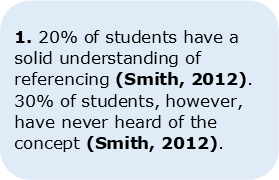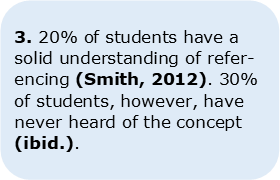How do I write accurate Harvard style citations?

This is the second and final chapter about Adding Harvard Citations. To complete this reader, read each chapter carefully and then unlock and complete our materials to check your understanding.
– Introduce three rules for knowing when to use the six reference elements that build citations
– Explore the formatting requirements of Harvard citations, such as punctuation, italics and capitalisation
– Troubleshoot citations that have missing source details
Chapter 2

In Chapter 1 of this short reader we reviewed referencing features and reference elements and connected these concepts with building citations in the Harvard style. We explored the four types of citation (integral, non-integral, multiple-source and secondary) and considered the six elements which build them. Next, in this second and final chapter, we explore when each reference element is required and how the four citation types should be formatted. We also help to troubleshoot some referencing challenges, looking at the rules for citing multiple authors, exploring what to do if source details are missing, and explaining how source-based information can be repeated across multiple sentences.
When is each reference element required?
As was explained in Chapter 1, there are six possible reference elements which are used to build citations in the Harvard style. These are included below with their related source details in brackets:
- Name of authors (Smith and Lee)
- Name of organisation (British Broadcasting Corporation)
- Year of publication (2019)
- Year of last update (2019)
- Page numbers (pp. 21-22)
- Web-page URL (https://academicmarker.com)
While these elements might seem easy enough to learn, what students may find challenging is knowing when to include each element in their citations. Thankfully, the following three rules can help students with this tricky aspect:
- Include the Name of authors when citing a source UNLESS (a) the author is an organisation (in which case include the Name of organisation) OR (b) you cannot find any author or authoring organisation.
- Include the Year of publication when citing a source UNLESS (a) the source is published online (in which case include the Year of last update) OR (b) you cannot find any publication date.
- Include Page numbers when citing printed quotes, graphic data or definitions UNLESS the quotes, graphic data or definitions are taken from a web page (in which case use a Web-page URL).
How should Harvard citations be formatted?
Rules of punctuation, spacing, italicisation and capitalisation are important when referencing. While citations may seem simple enough at first glance, these rules of formatting should be followed carefully and consistently. By studying the three diagrams below, students are provided with all of the formatting guidance they might need when building Harvard-style citations across various source types:



How should I cite multiple authors?
In addition to formatting, the task of including authors within a citation can be tricky, particularly if you’re not familiar with which names are the first and family names of a culture (Harvard citations should only include authors’ surnames). Determining how to list two, three, or four or more authors can also be challenging. Thankfully, there are three more simple rules that students can follow:
- When citing two authors, add an ‘and’ between the authors’ family names.
- When citing three authors, separate the first two authors’ names by a comma and the last two with an ‘and’.
- When citing a source that has four or more authors, use the Latin expression ‘et al.’ (meaning and others) in italics after the first author instead of laboriously writing out each author’s name.
Can a source be cited if it’s missing its details?
While many reference elements can simply be omitted if a source is missing its source details, there are two elements that impact the order and formatting of a citation when absent. These are the Name of authors and the Year of publication. Although our short reader on absent and similar source details explores this topic more comprehensively, three small rules can be followed when citing:
- If a source has no authors (or authoring organisations), use the Source title where the source authors would normally be.
- If a source has no publication year, use the phrase ‘no date’ instead.
- If a source has no authors or publication year, use a combination of rule 1 and 2 (and consider carefully whether that source is valuable enough to cite).
How do I repeat citations in the Harvard style?
One final situation you may find yourself in is when one sentence of your essay contains an accurate citation but the following sentence offers information from the same source. How would you repeat the source acknowledgement in this scenario? Many students are often confused about what to do, but thankfully there are three simple options which can be used in the Harvard style:
- Repeat the same citation from the first sentence in the following sentence.
- Use an alternate citation type to acknowledge the source again (i.e., if a non-integral citation is used the first sentence, the following sentence could use an integral citation).
- Use the Latin term ‘ibid.’ (meaning the same) to acknowledge that the information being cited comes from the previously cited source.




Good work on completing this short reader about adding Harvard citations to your academic assignments. If you haven’t already, consider completing our short reader on writing Harvard reference lists next, and don’t forget to also unlock, download and complete our Chapter 2 Worksheet to check your progress and improve your English.
To reference this reader:
Academic Marker (2022) Adding Harvard Citations. Available at: https://academicmarker.com/academic-guidance/referencing/referencing-styles/harvard-style/adding-harvard-citations/ (Accessed: Date Month Year).
Downloadables
Once you’ve completed both chapters in this short reader about Adding Harvard Citations, you might then wish to download our Chapter Worksheets to check your progress or print for your students. These professional PDF worksheets can be easily accessed for only a few Academic Marks.
Chapter 1 explores the topic: Does Harvard referencing use academic citations? Our Chapter 1 Worksheet (containing guidance, activities and answer keys) can be accessed here at the click of a button.
Chapter 2 explores the topic: How do I write accurate Harvard style citations? Our Chapter 2 Worksheet (containing guidance, activities and answer keys) can be accessed here at the click of a button.
To save yourself 1 Marks, click on the button below to gain unlimited access to all of our Adding Harvard Citations Chapter Worksheets. This All-in-1 Pack includes every chapter, activity and answer key related to this topic in one handy and professional PDF.
Collect Academic Marks
-
100 Marks for joining
-
25 Marks for daily e-learning
-
100-200 for feedback/testimonials
-
100-500 for referring your colleages/friends
To save yourself 1 Marks, click on the button below to gain unlimited access to all of our Adding Harvard Citations Chapter Worksheets. This All-in-1 Pack includes every chapter, activity and answer key related to this topic in one handy and professional PDF.